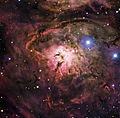Plik:Lagoon Nebula.jpg

Rozmiar podglądu – 610 × 599 pikseli. Inne rozdzielczości: 244 × 240 pikseli | 489 × 480 pikseli | 782 × 768 pikseli | 1043 × 1024 pikseli | 1841 × 1808 pikseli.
Rozmiar pierwotny (1841 × 1808 pikseli, rozmiar pliku: 2,92 MB, typ MIME: image/jpeg)
Historia pliku
Kliknij na datę/czas, aby zobaczyć, jak plik wyglądał w tym czasie.
| Data i czas | Miniatura | Wymiary | Użytkownik | Opis | |
|---|---|---|---|---|---|
| aktualny | 02:20, 4 mar 2014 |  | 1841 × 1808 (2,92 MB) | Lmbuga | Putting the nebula in the center of the image |
| 09:48, 9 sie 2012 |  | 2027 × 2064 (1,59 MB) | Fabian RRRR | higher resolution | |
| 09:32, 22 kwi 2010 |  | 1280 × 1303 (317 KB) | EricHS211 | {{Information |Description={{en|1=Infrared view of the Cat’s Paw Nebula (NGC 6334) taken by VISTA. NGC 6334 is a vast region of star formation about 5500 light-years from Earth in the constellation of Scorpius. The whole gas cloud is about 50 light-year |
Lokalne wykorzystanie pliku
Poniższa strona korzysta z tego pliku:
Globalne wykorzystanie pliku
Ten plik jest wykorzystywany także w innych projektach wiki:
- Wykorzystanie na ady.wikipedia.org
- Wykorzystanie na alt.wikipedia.org
- Wykorzystanie na av.wikipedia.org
- Wykorzystanie na bn.wikipedia.org
- Wykorzystanie na cs.wikipedia.org
- Wykorzystanie na cv.wikipedia.org
- Wykorzystanie na de.wikipedia.org
- Wykorzystanie na en.wikipedia.org
- Wykorzystanie na et.wikipedia.org
- Wykorzystanie na fr.wikipedia.org
- Wykorzystanie na hu.wikipedia.org
- Wykorzystanie na kaa.wikipedia.org
- Wykorzystanie na kk.wikipedia.org
- Wykorzystanie na koi.wikipedia.org
- Wykorzystanie na ko.wikipedia.org
- Wykorzystanie na kv.wikipedia.org
- Wykorzystanie na lez.wikipedia.org
- Wykorzystanie na mdf.wikipedia.org
- Wykorzystanie na mg.wikipedia.org
- Wykorzystanie na mk.wikipedia.org
- Wykorzystanie na mrj.wikipedia.org
- Wykorzystanie na olo.wikipedia.org
- Wykorzystanie na os.wikipedia.org
- Wykorzystanie na pt.wikipedia.org
- Wykorzystanie na ru.wikipedia.org
- Wykorzystanie na sah.wikipedia.org
- Wykorzystanie na sh.wikipedia.org
- Wykorzystanie na sk.wikipedia.org
- Wykorzystanie na sv.wikipedia.org
Pokaż listę globalnego wykorzystania tego pliku.


